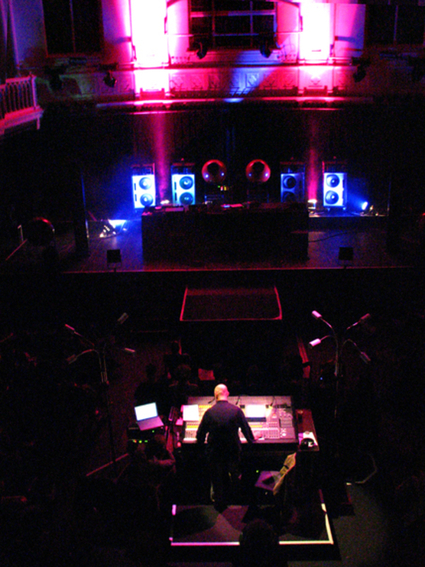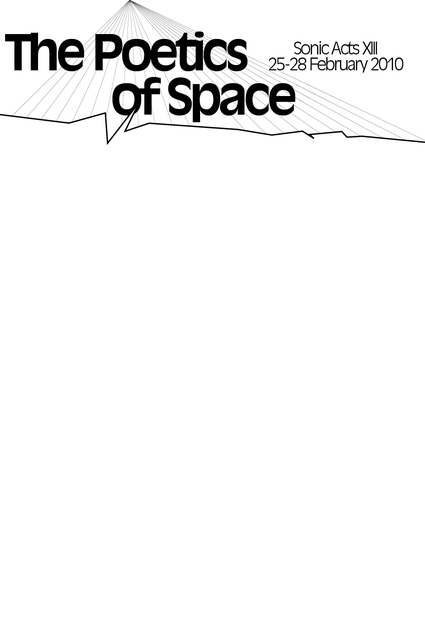Researching spatiality in the arts forms the core of the festival. How is space defined by a work of art? What does a viewer or listener experience? How do technological artworks deal with the visual, auditory and psychological aspects of spatiality? How has the relationship between technology, space and architecture developed over the past few centuries? How have technological developments influenced our perception and representation of space, and how do we relate to the space that surrounds us?
The programme comprises an overview of recent works and experiments - spatial audio compositions and audiovisual installations - and includes relevant historical examples and utopian ideals and dreams of the 20th century:
Conference
The three-day conference in De Balie forms the heart of the festival. Besides lectures and presentations, the comprehensive programme also features interviews, film screenings and short performances. An international gathering of theorists, artists, researchers, composers and critics will shed light on different aspects involved in working with space, centered on the theme: how does technology change our experience of space, how do artists investigate this in their work, and how do they enhance or modify the spatial experience?
The conference explores this theme during the lectures that link the history of (media) art with scientific and technological developments, drawing on architectural theory, phenomenology, psychophysics and even space travel. In addition the conference includes presentations that reveal how the boundaries of science and technology, and artistic utopias from the past, inspire contemporary artists in their spatial investigations of image and sound. A few catchwords: hybrid space, acoustic ecology, spatialized sound, domes, multiple-screen projections, sonic architecture... Cage & Hiller's HPSCHD, the Pepsi Pavilion, Blur Building, Recombinant Media Labs, Acousmatics, Vortex concerts....
Participants include Branden W. Joseph, Robert Whitman, Edward Shanken, Naut Humon, Trace Reddell, Douglas Kahn, Brandon Labelle, Roger Malina, Barry Truax, Hildegard Westerkamp, Eric Kluitenberg, Daniel Teruggi, Raviv Ganchrow, Dirk Hebel, Joerg Stollmann, and many more.
Concerts / Performances / Films
The evening programme in the Paradiso comprises a wide-ranging exploration of the spatial dimensions of image and sound and examines the relationship between spatial architecture and the listening ear and how our brains process sensory input. Events include immersive audiovisual performances, highly intensive listening experiences, experiments with spatial sound, multi-screen projections, films that extend beyond the screen and pure light.
The film programme includes important works from so-called Expanded Cinema. The 1970s saw a short-lived flourishing of artists and filmmakers who literally thought outside the box when it came to filmmaking and who re-investigated and explored all the accepted cinematographic conventions. They examined the spatial dimensions of film, ranging from films that are projected on multiple screens to films that explore the space between the projector and the screen, from live film performances to films as a medium conveying only spatial sound.
This part of the programme includes works by Paul Sharits, Anthony McCall, Takashi Ito, Yann Beauvais, and performances by Bruce McClure, Kanto Horio and others.
A subsidiary programme will feature documentaries about Expanded Cinema.
The four-hour-long programme devoted to the work produced by several generations of soundscape composers and field recordists promises to be an intense listening experience. Visitors enter a dark space and are confronted with recordings of thunderstorms and the sound of airplanes taking off, fragmented urban sound structures, singing deserts, and underwater or underground recordings that are transmitted by different arrays of speakers. Space is made audible and the spatial aspects of sound are integrated into the compositions, sometimes in very diverse ways.
With performances by Annea Lockwood, Jacob Kirkegaard, Barry Truax, BJ Nilsen, Eric La Casa, Gilles Aubry, Hildegard Westerkamp, and others.
The evening programme also features a tribute to the recently deceased innovative composer Maryanne Amacher. Light and sound performances by TeZ, Francisco Lopez and Evelina Domnitch & Dimitri Gelfland and others explore the potential of laser and light projections on the dome of the Planetarium - just one of the special locations in this year's festival.
There will also be an outdoor event by Duncan Speakman titled subtlemob, a blend of locative media, a soundwalk and performance.
Exhibition
Audio works and interactive installations can be viewed in the Netherlands Media Art Institute and at other special locations.
This part of the programme includes delicate light installations by Carlo Bernardini and HC Gilje, audio works by Jacob Kirkegaard that explore the mechanism of hearing and the resonances of space, a spatial composition machine by Ralf Baecker.
Carlo Bernardini makes abstract light installations that suggest spatiality. Rays of light delimit the space and create a geometrical sculpture.
HC Gilje's Blink investigates how audiovisual techniques and light can transform, enlarge, enhance and interpret physical spaces.
Jacob Kirkegaard's Labyrinthitis is an interactive audio work that acts on the inner ear: two frequencies produce a third frequency inside the ear.
Ralf Baecker's Rechnender Raum is a light-emitting geometrical sculpture made of sticks, wires and small pieces of lead that is simultaneously also a fully functioning neural network.
The exhibition in the NIMK will be open to the public until 1 May 2010.
More information on sonicacts.com

